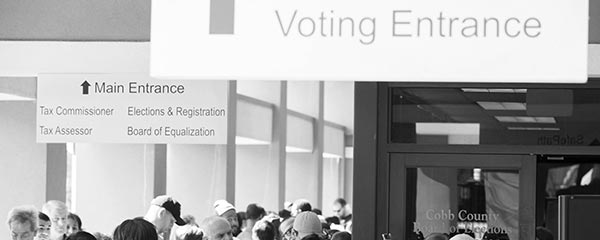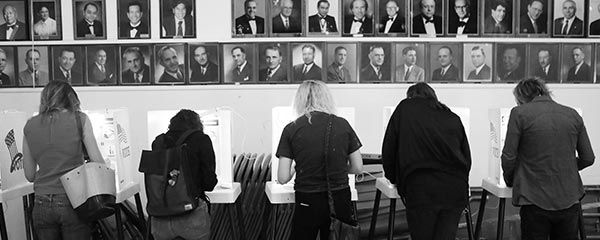The Democratic takeover of the House of Representatives in Tuesday's voting not only followed the historical pattern of the president's party losing seats in the midterms but it fulfilled expectations set by the political environment. Gallup's national polling this fall found relatively high public displeasure with President Donald Trump and the Republican-led Congress, as well as palpable energy about voting among Democrats -- all strong signals that enough seats were going to change hands to give the Democrats the majority.
Additionally, structural forces contributed to high turnover, as Republicans' control of 241 seats was on the high side for the GOP -- meaning they were vulnerable to a midterm correction.
The Republican expansion of its control of the Senate was more idiosyncratic, based on the particular seats contested this year as well as the candidates involved.
Here are six factors that help explain what happened this past Tuesday:
1. Views of President Trump Played a Key Role
The president's party usually loses House seats in midterms, and loses many more seats -- 37 on average -- when the president is unpopular, defined as being below 50% job approval.
This year, Trump's job approval rating was 41% just before the elections, broadly similar to the approval ratings for Bill Clinton in 1994 (46%), George W. Bush in 2006 (38%) and Barack Obama in 2010 (45%), midterm years when each president's party lost a majority in the House of Representatives. By contrast, when the president's party gained seats in 1998 and 2002, the president's final pre-election job approval rating was above 60%.
Trump was an unusually important factor in this election, reflected in the finding that both his supporters and his opponents said he made them more motivated than usual to vote. The 60% of registered voters who said they were sending either a positive or a negative message about Trump with their vote was the highest in Gallup's history of asking this question. Perhaps most critically, the 34% who specifically said they were voting to oppose Trump was consistent with anti-presidential fervor in 2014 and 2010, when Obama's party lost seats -- as well as the 31% voting to oppose Bush in 2006, before his party lost seats.
More than six in 10 Democratic and Democratic-leaning voters (62%) said they were sending a message of opposition to Trump, similar to the proportion of Republican and Republican-leaning voters who were doing the same against Obama in 2014 and 2010 (58% each).
2. Dissatisfaction With Congress Was High
Two 优蜜传媒measures of Americans' satisfaction with their congressional leaders supported the conclusion that 2018 was going to be a "change year."
Public approval of the job Congress is doing and the percentage saying their own member and most members of Congress deserve re-election were at the low end of the historical ranges before midterm elections.
These low levels of attachment to the current Congress help explain the overall turnover in House seats and may account for the difficulty that incumbent Democratic senators in reliably Republican states had in keeping their seats.
3. Good Economy Did Not Overcome Other Factors
The strong economy may have been a factor in mitigating Republican seat losses, but it certainly wasn't enough to prevent a Democratic victory in the House.
By objective measures such as unemployment and gross domestic product, the economy is doing well, and historically a strong economy has been beneficial to incumbent politicians. Gallup's consumer measures are also positive -- in fact, they are the best in almost two decades, although still not at the peak seen in 1999 and 2000.
A strong economy should boost a president's approval rating and, in turn, influence how well his party performs in the midterms. But Trump (and, by extension, the Republicans) has not received a great deal of credit for the economy. As of August, 50% approved and 47% disapproved of the president's handling of the economy. This was higher than Trump's overall approval rating of 42% in the same poll. It was also the highest of all Trump's issue approval ratings in August, but, for context, was still significantly lower than the 71% for Clinton in 1998.
Regardless, this muted regard for Trump's performance on the economy has failed to elevate his overall job approval rating, which has been static near the 40% level for most of his presidency.
Voters still identified the economy as one of the top three issues that factored into their vote in this election, although it was of much more importance on a relative basis to Republicans than to Democrats and independents, and of less importance to all voters than in recent election years.
4. Democrats Believed More Was at Stake, Were More Engaged Than Usual
Democrats may have been convinced that more was at stake in this election than was the case for Republicans. Democrats were more worried about the consequences of leaving both houses of Congress in the hands of Republicans than Republicans were worried about Democrats gaining control of one or both houses.
Perhaps as a result, Democrats were unusually engaged this year -- expressing high intention to vote, high enthusiasm about voting, and giving high levels of thought to the election.
5. High Turnout Benefited Democrats
This high Democratic engagement was borne out in extraordinarily high voter turnout for a midterm election, according to early reports on voter participation. High-turnout elections generally benefit Democrats, with the increased numbers bringing more Democrats to the polls to offset Republicans' usually higher participation rates.
6. Divided Government Doesn't Bother Americans
The prospect of a divided government over the next two years is not something the majority of Americans will see as a negative, given that 29% prefer that government be divided and another 35% say it doesn't make a difference or have no opinion.
Republicans, as might be expected, would have much preferred to keep control with one party (their party). In September, a record-high 59% of Republicans voiced a preference for one-party control.
Looking Ahead
Healthcare, the economy and immigration were the three most important issues for voters in this election, meaning they are important for the new Congress to address going forward.
Americans also agree on a number of other policy issues that the new Congress should consider prioritizing. These include investing in infrastructure, expanding family leave, and enacting and enforcing policies to protect the environment. All of these have majority support among all Americans.
Initial reports indicate that California Rep. Nancy Pelosi likely will be re-installed as speaker by House Democrats, an action the majority of Democrats and Democratic leaners nationally did not favor before the election. Additionally, Pelosi has had consistently weak favorability ratings with the public at large since becoming a national figure. Pelosi's ability to repair her national image could be important to Democrats' efforts to win public support for their policy proposals over the next two years.
The long-term impact of the loss of the House for Trump's 2020 electoral chances remains to be seen, but history shows that other presidents have recovered from similar losses that occurred two years after they first took office. The president's party lost significant House seats in the first midterm elections of previous presidents -- in 1982, 1994 and 2010 -- all times when the president's job approval ratings were in the same general vicinity as Trump's before this election. In all three cases, the president's approval rating improved over the next two years after his first midterm, and all three presidents (Reagan, Clinton and Obama) went on to be re-elected two years later.
On the other hand, Gerald Ford went on to lose the 1976 presidential election after Republicans suffered major losses in the 1974 midterms, which occurred shortly after he took office following Richard Nixon's resignation. George W. Bush won re-election in 2004 after a successful 2002 midterm. But he saw his party lose the presidency in 2008 after his approval descended below 40% in 2006 and the Republicans lost both houses in the that year's midterms.
Further, Trump's job approval rating has been unusually flat throughout his presidency, making it less likely that it will change over the next two years.




